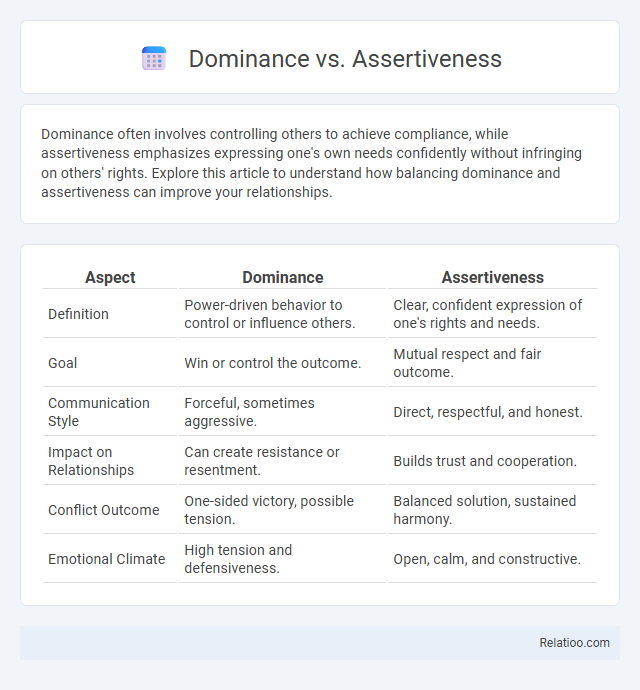Dominance often involves controlling others to achieve compliance, while assertiveness emphasizes expressing one's own needs confidently without infringing on others' rights. Explore this article to understand how balancing dominance and assertiveness can improve your relationships.
Table of Comparison
| Aspect | Dominance | Assertiveness |
|---|---|---|
| Definition | Power-driven behavior to control or influence others. | Clear, confident expression of one's rights and needs. |
| Goal | Win or control the outcome. | Mutual respect and fair outcome. |
| Communication Style | Forceful, sometimes aggressive. | Direct, respectful, and honest. |
| Impact on Relationships | Can create resistance or resentment. | Builds trust and cooperation. |
| Conflict Outcome | One-sided victory, possible tension. | Balanced solution, sustained harmony. |
| Emotional Climate | High tension and defensiveness. | Open, calm, and constructive. |
Understanding Dominance and Assertiveness
Understanding dominance involves recognizing power dynamics where influence and control are exerted over others, often through authoritative behavior. Assertiveness refers to confidently expressing your thoughts, needs, and rights without infringing on others' boundaries, promoting respectful communication. You can develop assertiveness to communicate effectively while avoiding the pitfalls of dominance that may undermine relationships.
Key Differences Between Dominance and Assertiveness
Dominance and assertiveness are distinct communication styles that influence interpersonal dynamics; dominance often involves control and authority, while assertiveness emphasizes confidence and clarity without aggression. You express assertiveness to respect your own needs and opinions while maintaining others' rights, whereas dominance can overshadow collaboration by prioritizing power. Understanding these key differences enhances effective leadership and relationship management.
The Psychology Behind Dominant Behavior
Dominant behavior, rooted in evolutionary psychology, reflects an instinctual drive to assert control and influence over social hierarchies, often linked to confidence and resource acquisition. Assertiveness differs by emphasizing clear, direct communication without aggressive intent, enabling you to express needs while maintaining respect for others. Understanding the psychology behind dominance reveals how perceived power and social status impact your interactions and decision-making processes.
Assertiveness: Definition and Core Traits
Assertiveness is the confident and respectful expression of one's opinions, needs, and rights without infringing on others, characterized by clear communication, self-assurance, and emotional regulation. Core traits of assertiveness include directness, honesty, and the ability to set boundaries effectively while maintaining interpersonal respect. Unlike dominance, which involves control and authority, assertiveness fosters mutual respect and balanced interaction in personal and professional relationships.
Effects of Dominance in Personal and Professional Relationships
Dominance in personal and professional relationships often results in increased control and influence over others, which can both facilitate leadership and create power imbalances. Excessive dominance may lead to conflict, reduced collaboration, and hindered communication, whereas balanced assertiveness promotes mutual respect and effective problem-solving. Understanding the effects of dominance helps in managing interpersonal dynamics to foster healthier, more productive environments.
Benefits of Assertiveness in Communication
Assertiveness in communication empowers you to express your thoughts and needs clearly while respecting others, fostering trust and mutual understanding. Unlike dominance, which can create conflict, assertiveness encourages collaborative problem-solving and strengthens relationships. Benefits include enhanced self-confidence, reduced stress, and more effective conflict resolution skills.
Recognizing Dominant vs Assertive Communication Styles
Recognizing dominant communication involves identifying a controlling tone, aggressive commands, and a desire to assert power over others, which can often lead to resistance or conflict. Assertive communication emphasizes clarity, confidence, and respect for others' opinions, allowing You to express your needs without undermining relationships. Distinguishing between dominance and assertiveness helps improve interpersonal dynamics by promoting constructive dialogue and minimizing misunderstandings.
How to Develop Assertiveness Without Becoming Dominant
Developing assertiveness involves expressing your thoughts and needs confidently while respecting others' boundaries, unlike dominance which often overrides others' perspectives. Techniques to build assertiveness include practicing clear communication, setting boundaries, and using "I" statements to express feelings without aggression. Maintaining empathy and active listening ensures assertiveness remains collaborative rather than controlling or authoritarian.
Common Misconceptions About Dominance and Assertiveness
Dominance is often misunderstood as aggressive control, while assertiveness actually involves confident, respectful communication without intimidation. Many confuse dominance with leadership, but true assertiveness emphasizes clear boundaries and mutual respect rather than power assertion. Recognizing that dominance can hinder collaboration whereas assertiveness fosters effective dialogue helps clarify these key behavioral differences.
Choosing Assertiveness Over Dominance for Lasting Influence
Choosing assertiveness over dominance fosters more sustainable and positive influence by promoting open communication and mutual respect. Assertiveness empowers individuals to express their needs and boundaries clearly without undermining others, leading to healthier relationships and cooperative environments. Emphasizing assertive behavior enhances leadership effectiveness and long-term trust compared to dominance, which can generate resistance and conflict.

Infographic: Dominance vs Assertiveness
 relatioo.com
relatioo.com